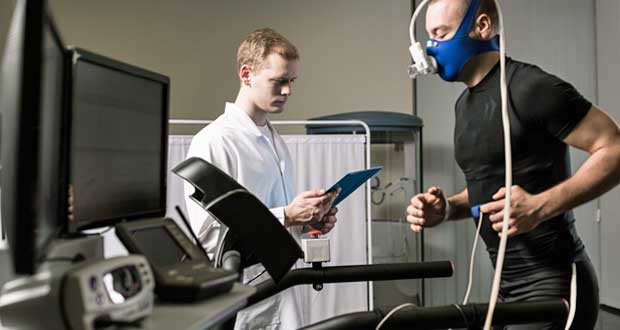What is VO2?
VO2 is a measurement for an individual's rate of oxygen consumption. In other words, VO2 measures how much oxygen your body uses. Oxygen is used to make energy for your body.
How is VO2 measured?
On the SlateSafety Platform, VO2 is estimated in milliliters per kilogram per minute (mL/kg/min). VO2 can be expressed as an absolute VO2 (mL/min) value or as a relative VO2 (mL/kg/min) value. SlateSafety BAND V2 measures relative VO2 because it takes into account the mass in kilograms of the individual. Relative VO2 allows for better comparison between people of different body sizes.

Source: SHUTTERSTOCK
In a clinical or research setting, VO2 can be measured using a metabolic cart to literally measure the amount of oxygen consumption. The SlateSafety BAND V2 is able to estimate VO2 using a correlation between heart rate and VO2.
What is VO2 used for?
The more you exert yourself, the more oxygen you will need to consume, so a high VO2 is correlated with a high exertion. The reverse is also true: the more oxygen you consume, the more you are able to exert yourself.
The maximal amount of oxygen you are able to consume is called your VO2max. VO2max is simply the highest recorded VO2 value during a progressive maximal effort. Therefore, VO2max is a fitness metric that can quantify the max amount of physical effort you are able to exert. On average, sedentary males have a VO2max of roughly 35 to 40 mL/kg/min, whereas females will have a VO2max of around 26 to 30 mL/kg/min. Trained individuals will have higher VO2max values in the 40s or even 50s, but it is very difficult and unique to achieve a VO2max higher than 60.
While a high VO2max is a good sign of your ability to exert yourself, working at a high VO2 means that you are currently exerting yourself and could potentially be at risk for overexertion injuries.
By looking at VO2, you can get a sense of one's level of exertion. Below is a table that categorizes typical values for normal, moderate and high exertion levels.
| Normal Exertion | Moderate Exertion | High Exertion |
| Below 30 mL/kg/min | 30-45 mL/kg/min | Over 45 mL/kg/min |
| Resting or putting in a normal amount of effort. Minimal risk of overexertion injury. | Untrained individuals at their max effort and may be at risk of injury. Trained individuals are likely okay. | Untrained individuals at high risk of injury. Trained individuals are at their max effort and may be at risk of injury. |